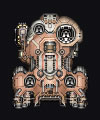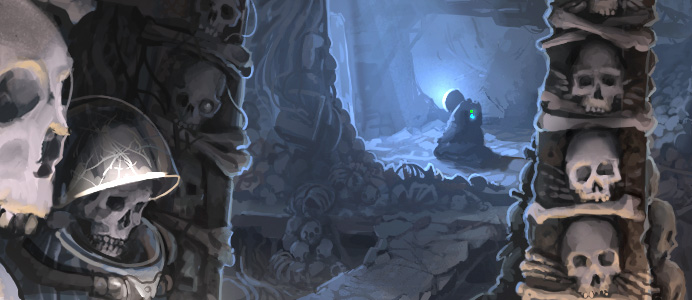When I was first drawing up spaceships for Starsector we determined what to make based mostly on what felt right according to the conceit of idealized WW2-era naval combat in space. Obviously we needed a big battleship (the Onslaught), cheap swarming fighters (the Talon), a nimble frigate (the Wolf), and a giant carrier (the Astral), etc. The roles and variations of ships pretty much suggest themselves, and the form follows their function. If it’s a battleship, it should look like its tough and packs a heck of a punch. I’ve certainly drawn a few ships without a hard plan upfront but even then I’m always thinking about what kind of role the ship in question is going to play in the game.
It’s just the way I work: Form necessarily reflects function, to my mind. The visual logic of a game should have internal consistency whether it has much relation to real-life realism or not, but it can at least point to real-life aesthetic references for the feeling or idea, if not actual function. So if you sit back and consider what a battleship would really look like in space, it’d probably look like nothing because the display scale would make it a dot that says “Space Battleship” next to it, or as soon as combat began it’d be immediately destroyed by lasers or relativistic kill vehicles or something because it’s a big dumb target — but all hope is not lost! Our game sprite can make visual reference to a 20th century naval warship because my goal is to convey the feeling of battleship to people who have been trained to believe that a battleship looks a certain way, not to create a hyper-realistic near-future space combat simulation. (More on this in the “Ship Design & The Onslaught” post from back in 2010.)
Right, so this is how development of Starsector’s ships has progressed and the big gaps in fleet lineup have been largely filled in. Again, this process largely took place without need for any kind of overarching plan, though occasionally Alex would say “hey, we need a frigate that does this“, or we might talk it over and try something experimental in terms of gameplay. Some experiments worked, some were modified a bit from what was first imagined– phase ships for example — and others never really took off at all, eg. munition ships. But that said, the large part of fleet combat roles is fleshed out; Now is a matter more of filling in small gaps that exist, diversifying existing roles to support the game’s setting and ‘landscape of player progression’. Still, the experiments are lots of fun! (More on this with the Monitor.)
Now I’m taking on more of a role in writing setting & backstory for Starsector. When drawing a ship I’ll think not only of the gameplay function but of the narrative role it fulfills; The possibilities are absolutely fascinating! A simple sprite can, given appropriate text, suggest an awful lot about the universe it exists within and it can draw connections to other ships, factions, places, history, and all of that to emotional responses from the player as they decide how they feel about the ships, factions, and places in the universe of Starsector. Each piece becomes something far greater than the sum of its parts when this all operates together (and I love this part of game development).
Okay, that’s enough rambling: I’ll show off some new ships, discuss their envisioned role in gameplay (which we recognize, dear players, is not necessarily how you’re going to use them), then a bit about how their backstory fits together with the rest of Starsector.
Cerberus
 This one is easy: Everyone loves the Hound so why not build a bigger Hound? And that about explains everything you need to know. (The working title for sprite was, naturally, “superhound.psd”. )
This one is easy: Everyone loves the Hound so why not build a bigger Hound? And that about explains everything you need to know. (The working title for sprite was, naturally, “superhound.psd”. )
As for drawing, I’ve been tending toward more curved plating and slightly subtler shading. I’m trying to get away from having too much “greeble noise” covering ships so that the overall form doesn’t devolve into so much pixel noise, and so it gets more of a chance to make itself seen. This should result in a ship that’s more visibly identifiable at a glance and it ought to look better when scaled down or zoomed out rather than drawn at pixel-perfect resolution, as is often the case for ships in Starsector. You can still see the Hound parts used as a base for the image, however ( … and man is it ever just a brick of a ship!)
Read the rest of this entry »




 This one is easy: Everyone loves the Hound so why not build a bigger Hound? And that about explains everything you need to know. (The working title for sprite was, naturally, “superhound.psd”. )
This one is easy: Everyone loves the Hound so why not build a bigger Hound? And that about explains everything you need to know. (The working title for sprite was, naturally, “superhound.psd”. )





















